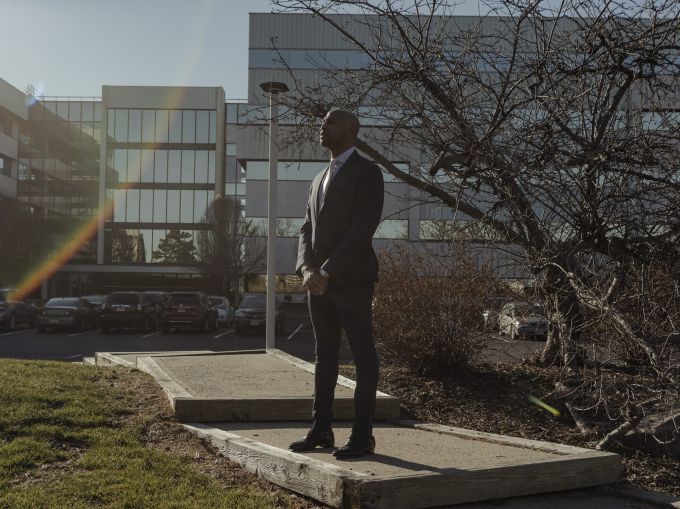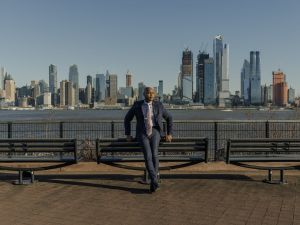Nuveen’s Nadir Settles Talks Life Sciences, COVID, NYC’s Future
Nadir Settles has already made some extremely shrewd decisions for the real estate giant, rocky times or not.
By Nicholas Rizzi February 1, 2021 11:00 am
reprints
Getting a life sciences project off the ground in New York City might have been a good move in 2019, but doing so last year seems timed to perfection.
Despite the upheaval the pandemic reaped on the commercial real estate market, the life sciences sector has seemed to be pandemic-proof with institutional investors rushing to add it to their portfolios. But they’ll have to catch up with the likes of Nuveen Real Estate’s Nadir Settles, who’s in charge of the global asset manager’s New York City portfolio.
In October, Nuveen and Taconic Partners unveiled their plans to turn 125 West End Avenue, part of the former ABC Upper West Side campus that the pair bought in 2019, into a 400,000-square-foot life sciences hub.
“We were well ahead of it, and after the pandemic, this kind of research and focus on curing viruses just became more and more of a focus,” Settles said. “Now, every investor wants this alternative to office. We either got lucky or we were really smart.”
While Settles might chalk it up to luck, his past says otherwise.
The Bronx native was always interested in real estate, saying he often wondered who owned those massive office buildings when he visited Manhattan with his family. Eventually, Settles joined the companies that did.
He got his first job in real estate after he met RLJ Lodging Trust CEO Leslie Hale — the first Black woman to become CEO of a publicly traded real estate investment trust (REIT) — as part of the INROADS program aimed to help minorities gain footing in corporate America. That meeting eventually led to Settles getting a job at RLJ, where he was a financial analyst.
Settles then got into the city’s commercial real estate world when he joined Silverstein Properties on its asset management side, where he worked on the landlord’s 6.2 million-square-foot portfolio. He left in 2011 and took a job at TH Real Estate, which TIAA eventually acquired and rebranded Nuveen.
Nuveen is currently one of the top investment managers in the country, with an $88 billion portfolio in North America, and its assets in the city include 21 Penn Plaza, 440 Ninth Avenue and 817 Broadway.
And, aside from its life science campus in the works on the Far West Side, Nuveen is also working with Taconic on getting an office tower at 2 Hudson Square off the ground, a $120 million renovation to its office building at 730 Third Avenue, and another $40 million makeover of its property at 780 Third Avenue.
Commercial Observer sat down virtually with Settles, a father of two girls who lives in Paramus, N.J., to talk about the pandemic’s impact on Nuveen’s portfolio, its life sciences play, and its future acquisition plans in New York City.
Commercial Observer: How has the pandemic changed the way Nuveen manages its portfolio?
Nadir Settles: In general, the pandemic has just put an acceleration on everything from how you look at your assets from a health and wellness perspective, how you look at it from a technology perspective, how you look at it from an amenity perspective and sustainability.
That’s in our DNA, sustainability, and we were already incorporating that in our assets. In one redevelopment [780 Third Avenue], we’re building a park. We’re taking what was the streetscape and we’re actually building a manufactured park that could serve the neighborhood and tenants.
Then, with the pandemic, we started thinking about what is the best health and wellness that we should adopt in the building itself. We started to do a forensic analysis on the frequency of cleaning and what’s the best practice for that.
We’ve been looking at how to incorporate flex offerings to accommodate growth as well as flexibility. We’re hearing a lot that tenants won’t want to sign longer-term leases, so to be able to have a plug-and-play offering within a building — that incorporates best practices from building programming, technology, and health and wellness — we think that will attract tenants.

Obviously, life sciences is a sector that has gotten a lot of attention during the pandemic. What drew you to it in the first place?
We were certainly ahead of this, and I’d like to say we were smart enough to know that it was going to catch this much fire, especially by institutional investors.
Our partners, Taconic, had experience right down on 54th Street — so, 10 blocks south — with a development that was the Hudson Research Center. Due to that success, we really got to understand and learn the life science market, how it works from all of the tenants, how the funding works and the lack of supply.
We were able to buy this campus when it came up for sale, and this was in 2018, and the world was totally different, and we said this is going to be a great execution. And we figured we could build our own hub, because we had the building 10 blocks south, and now we have this building that we’re about to acquire.
Are you looking to do more in this space in the future?
We’re looking for more and I think we will do more. I think it’s a space that certainly has a tailwind and it certainly has a lack of supply in the market. It has the talent here, and so, if we can do more of it, we certainly want to do more and we’re evaluating opportunities now. There are limitations.
For one, life science tenants like to be in a cluster. That’s very important for those tenants in that sector. Then, two, even if you were able to create a cluster, every building just doesn’t have the physical attributes to be able to reposition. There are some barriers to entry. You can’t just say this building is functionally obsolete, let me just take it, knock it down and rebuild it as life science. You have to be able to salvage some of the bones.
For instance, the building at 125 West End used to be a Chrysler showroom, so you could understand how that was the right floor load, it had the right physical infrastructure.
Because of all the attention on the sector, and since not every building works for it, has that made it a lot more competitive?
I think it has made it more competitive. When we were out talking about this stuff two, three years ago, I think it was a novel idea. People were like, ‘Oh, that’s interesting,’ but it was more alternative and not mainstream. Now it has become mainstream. I still think it is a space that you have to be operationally sophisticated in, so I think that will be a barrier to entry.
Nuveen released a paper recently about the future of investing in the city. Can you talk about that and the assets you’re looking at this year?
New York was the epicenter of the pandemic, it was the first to see the devastation of what the pandemic has done. It got hit hard first and that caused opportunities. Fundamentally, we feel good about New York, investing in New York, and we’ve seen this before. New York was the epicenter, but in all recessions, it seems like New York got hit hard first and it actually bounces first. It seems like we’ve taken our blow, and now, our better days are ahead of us. With two vaccines in distribution, we feel really confident that New York will bounce back.
There’s a lot of corporate transactions that are betting on New York for the long term. When we talk about this exodus, there are corporations that are saying, ‘We’re going to work from home,’ and they’re sort of saying one thing and they’re doing another. When you see some of these long-term leases or these purchases that have been done during 2020, when, at the minimum, these corporations could’ve just held back, but they went ahead and transacted because they are betting on New York for the long term.
We know that New York City is going to bounce back and, in times of distress and market relocation, there are going to be opportunities that come out of that. We still like traditional office in resilient submarkets. We still love markets that are transit-oriented, work-live-play, like Midtown South and Hudson Square. And we love a boutique building that we can program from our perspective of providing the right enhanced technology, health and wellness, and sustainability.
Are you seeing any discounts on the assets you’re looking at?
Not much has traded. So, you had Amazon (AMZN) buy the Lord & Taylor building, and you had some other trades, but the trades that you had were pre-pandemic. Those trades were locked up pre-pandemic, so there wasn’t much of a discount.
What was different about this downturn, that didn’t allow for any value seekers to be able to pursue assets with an immediate discount, is because a lot of people with busted business plans or debt that came due, a lot of lenders basically kicked the can down the road. So, they let those they sponsored live to see another day, and I think that day has come now.
So, now, when they came back up to those six- or 12-month modifications, [lenders say] ‘You know what? I feel I can see clarity. I can see people talking about returning to the office, my own company is starting to talk about our plans. There’s a vaccine that’s in circulation, you know what, find another alternative source of financing.’ And that’s where we think we’ll see the first wave of new transactions coming and we’ll see some nice pricing.
Are you seeing opportunities to step into troubled situations or are you looking to acquire properties straight out?
We think that there’ll be a number of opportunities to step in and do a number of things — whether we’re like rescue capital, whether we provide some sort of mezzanine financing, or whether we provide equity. That’s where we can be flexible and we are talking to some folks. That’s where the first wave of opportunities are going to come. It’s what I call generally structured space, because those deals require a lot of structuring.
What do you think the second wave is going to look like?
I expect sellers to just start to capitulate and say, ‘My business plan’s been busted for about 15 months now, it’s just hard to have a busted business plan pick back up where you left off. [Tenant improvements] have gone up, rents have gone down. My value is impaired, I’m just going to sell.’ That’s where we can get that asset at an amazing price.
But that’s one aspect of the second wave. The second aspect is portfolio clearing. If I’m having trouble with my portfolio and this asset will help me to, at least, provide myself some liquidity, it’s a nice asset. I can take it out to market, it’s a quick execution, and it will garner some attention. That’s where people will sell for some discount. It wasn’t necessarily [that] the asset was troubled, but their portfolio is troubled at this point and they need to be able to solve all their fires in their portfolio.
When people are nervous that the lending markets are going down, they’re nervous if tenants are going back to the market. We have a high conviction; we have an investment thesis around the type of assets to buy, the markets we want to be in, the business plans we want to pursue, and we just got to stay focused.
With buyers being nervous if tenants are going to return, does that make it stressful for you when picking up the asset?
No, it’s perfect for us. Because the buyer that did these deals pre-COVID, you have a lot of stress, because you paid a price for this based on where you thought you could execute on the business plan. For us, coming in right now, we’re underwriting that so we’re giving ourselves more downtime to secure tenants. We’re underwriting higher T.I.s, we’re underwriting lower rent.
And the price we paid for it actually contemplates all of these challenges and slow recovery. If we think the world’s going to rebalance in 2023 and it takes us to 2024, we’re actually underwriting a little bit more conservative so that we’ve built a little bit of cushion.
That’s the benefit of buying in a downturn. You’ve got perfect visibility into the concerns you should be incorporating into your business plan.


